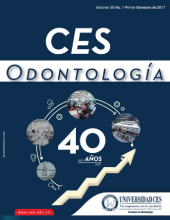Clinical aspects of dental fluorosis according to histological features: a Thylstrup Fejerskov Index review
DOI:
https://doi.org/10.21615/cesodon.30.1.4Keywords:
dental fluorosis, diagnosis, classificationAbstract
Dental fluorosis is a developmental defect of enamel caused by chronicand excessive fluoride intake resulting in a hypomineralized enamel withincreased porosity. It is clinically identified as spots ranging from mild whitelines to opaque spots covering all or part of the enamel surface andbreakdown after teeth eruption. However, the clinical definition of the fluorosisdegree in teeth is not an easy task, having been presented many indicesthat generally qualify the severity degree with variations in the details.As the choice of treatment is closely linked to the defect severity, the purposeof this article is to present the clinical aspects of dental fluorosis representedthrough the Thylstrup-Fejerskov Index. The severity scores arepresented according to histological features and the differences betweenthem will be discussed in order to enable the dentist to correctly diagnoseand choose the most appropriate treatment for the patient with DF.
Downloads
References
Buzalaf MAR, Cury JA, Whitford GM. Fluoride exposures and dental fluorosis: A literature review. Rev Fob. 2001; 9(1/2): 1-10. https://sddinforma.files.wordpress.com/2010/07/2001101.pdf
Molina-Frechero N, Gaona E, Angulo M, Sánchez Pérez L, González González R, Nevarez Rascón M, et al. Exposure Effects and Dental Fluorosis in Children in Mexico City. Med Sci Monit. 2015; 21: 3664-3670. https://www.ncbi.nlm.nih.gov/pubmed/26609898
Vijayran M, Manuja N, Chaudhary S, Sinha A, Chaitra TR. Co-relation of body mass index, dental caries and periodontal status fluorosis in different high fluoridated areas of Haryana state. Indian J Dent Res. 2014; 25(6): 722-728. https://www.ncbi.nlm.nih.gov/pubmed/25728103
Fejerskov O, Baelum V, Manji F, Moller IJ. Fluorose dentária: um manual para profissionais de saúde. São Paulo: Editora Santos; 1994.
Whelton HP, Ketley CE, McSweeney F, O’Mullane DM. A review of fluorosis in the European Union: prevalence, risk factors and aesthetic issues. Community Dent Oral Epidemiol. 2004; 32 (1 Suppl): 9-18. https://www.ncbi.nlm.nih.gov/pubmed/15016112
Richards A, Kragstrup J, Josephsen K, Fejerskov O. Dental fluorosis developed in post-secretory enamel. J Dent Res. 1986; 65(12): 1406–9.https://www.ncbi.nlm.nih.gov/pubmed/3465769
Alvarez JA, Rezende KM, Marocho SM, Alves FB, Celiberti P, Ciamponi AL. Dental fluorosis: Exposure, prevention and management. Med Oral Patol Oral Cir Bucal. 2009; 14(2): 103–107. https://www.ncbi.nlm.nih.gov/pubmed/19179949
Everett ET. Fluoride’s effects on the formation of teeth and bones, and the influence of genetics. J Dent Res. 2011; 90(5): 552-560. https://www.ncbi.nlm.nih.gov/pmc/articles/PMC3144112/
Aoba T, Fejerskov O. Dental fluorosis: chemistry and biology. Crit Rev Oral Biol Med. 2002; 13(2): 155-170. https://www.ncbi.nlm.nih.gov/pubmed/12097358
Tenuta LM, Cury JA. Fluoride: its role in dentistry. Braz Oral Res. 2010; 24(1 Suppl): 9-17.https://www.ncbi.nlm.nih.gov/pubmed/20857070
Montero MJ, Douglass JM, Mathieu GM. Prevalence of dental caries and enamel defects in Connecticut Head Start children. Pediatr Dent. 2003; 25(3): 235-239. https://www.ncbi.nlm.nih.gov/pubmed/12889699
Rozier, RG. Epidemiological indexes for mensuring the clinical manifestations of dental fluorosis: overview and critique. Adv Dent Res. 1994; 8(1): 39-55.http://journals.sagepub.com/doi/pdf/10.1177/08959374940080010901
Thylstrup A, Fejerskov O. Clinical appearance of dental fluorosis in permanent teeth in relation to histological changes. Community. Dent Oral Epidemiol. 1978; 6(6): 315-328. http://onlinelibrary.wiley.com/doi/10.1111/j.1600-0528.1978.tb01173.x/epdf
Pereira AC, Moreira BH. Analysis of three dental fluorosis indexes used in epidemiologic trials. Braz Dent J. 1999; 10(1): 29-37. https://www.ncbi.nlm.nih.gov/pubmed/10863387
Alkhatib MN, Holt R, Beti R. Aesthetically objectionable fluorosis in the United Kingdom. Br Dent J. 2004; 197(6): 325-328. https://www.ncbi.nlm.nih.gov/pubmed/15454999
Azevedo MS, Goettems ML, Torriani DD, Demarco FF. Factors associated with dental fluorosis in school children in southern Brazil: a cross-sectional study. Braz Oral Res. 2014; 28(1): 1-7. https://www.ncbi.nlm.nih.gov/pubmed/24878674
Oliveira BH, Milbourne P. Fluorose dentária em incisivos Superiores permanentes em crianças de escola pública do Rio de Janeiro. Rev Saúde Pública. 2001; 35(3): 276-282. http://www.scielo.br/pdf/rsp/v35n3/5013.pdf
Fejerskov O, Johnson NW, Silverstone LM. The ultrastructure of fluorosed human dental enamel. Scand J Dent Res. 1974; 82(5): 357-72. https://www.ncbi.nlm.nih.gov/pubmed/4528817
Den Besten PK. Biological mechanisms of dental fluorosis relevant to the use of fluoride supplements. Community Dent Oral Epidemiol. 1999; 27(1): 41-47. http://onlinelibrary.wiley.com/doi/10.1111/j.1600-0528.1999.tb01990.x/pdf.
Denbesten P, Li W. Chronic fluoride toxicity: dental fluorosis. Monogr Oral Sci. 2011; 22: 81-96. https://www.ncbi.nlm.nih.gov/pubmed/21701193
McDonagh MS, Whiting PF, Wilson PM, Sutton AJ, Chestnutt I, Cooper J, et al. Systematic review of water fluoridation. BMJ. 2000; 321(7265): 855-859. https://www.ncbi.nlm.nih.gov/pubmed/11021861
Limeback H. Enamel formation and the effects of fluoride. Community Dent Oral Epidemiol, 1994; 22(3): 144-147. https://www.ncbi.nlm.nih.gov/pubmed/8070240
Frazão P, Peverari AC, Forni TIB, Mota AG, da Costa LR. Dental fluorosis: comparison of two prevalence studies. Cad. Saúde Pública, Rio de Janeiro. 2004; 20(4): 1050-1058. https://www.ncbi.nlm.nih.gov/pubmed/15300298
Pascoe L, Seow WK. Enamel hipoplasia and dental caries in Australian Aboriginal children: prevalence and correlation between the two diseases. Pediatr Dent. 1994; 16(3): 193-199. https://www.ncbi.nlm.nih.gov/pubmed/8058543
Marthaler TM. Increasing the public health effectiveness of fluoridated salt. Schweiz Monatsschr Zahnmed. 2005; 115(9): 785-792. https://www.ncbi.nlm.nih.gov/pubmed/16231748
Moimaz SAS, Saliba O, Chiba FY, Sumida DH, Garbin CAS, Saliba NA. Fluoride concentration in pubic water supply: 72 months of analysis. Braz Dent J. 2012; 23(4): 450-456. https://www.ncbi.nlm.nih.gov/pubmed/23207865
Broffitt B, Levy SM,Warren JJ, Heller KE. Seasonal variation in fluoride intake: the Iowa fluoride study. J Public Health Dent. 2004; 64(4): 198-204.https://www.ncbi.nlm.nih.gov/pubmed/15562941
Moura MS, Gomes LMA, Castro MRP, Teles JBM, Moura LFAD. Dental fluorosis in 12-year-old adolescents. RGO. 2010; 58(4): 463-468. http://revodonto.bvsalud.org/pdf/rgo/v58n4/a06v58n4.pdf
Marthaler TM. Salt fluoridation and oral health. Acta Med Acab. 2013; 42(2): 140-55. https://www.ncbi.nlm.nih.gov/pubmed/24308394
Alaluusua S, LukinmaaPL, Koskimies M, Pirinen S, Hölttä P, Kallio M, et al. Developmental dental defects associated with long breast feeding. Eur J Oral Sci. 1996; 104(5-6): 493-497. https://www.ncbi.nlm.nih.gov/pubmed/9021315
Mehta DN, Shah J. Reversal of dental fluorosis: A clinical study. J Nat Sci Biol Med. 2013; 4(1): 138-144. https://www.ncbi.nlm.nih.gov/pmc/articles/PMC3633264/
Campos C, Toledo AO, Bezerra AC. Prevalence of dental fluorosis in school children from Brasília-Federal District. Rev Odontol Univ São Paulo.1998; 12(3): 225-230. http://www.scielo.br/scielo.php?script=sci_arttext&pid=S010306631998000300005
Thylstrup A. Is there a biological rationale for prenatal fluoride administration?.ASDC J Dent Child.1981; 48(2): 103-108. https://www.ncbi.nlm.nih.gov/pubmed/6938542
FDI Commission on Oral Health. A review of the developmental defects of enamel index (DDE Index). Int Dent J. 1992; 42(6): 411-426. https://www.ncbi.nlm.nih.gov/pubmed/1286924
Denis M, Atlan A, Vennat E, Tirlet G, Attal JP. White defects on enamel: diagnosis and anatomopathology: two essential factors for proper treatment (part 1). Int Orthod. 2013; 11(2): 139-165. https://www.ncbi.nlm.nih.gov/pubmed/23597715
Weerheijm KL, Duggal M, Mejàre I, Papagiannoulis L, Koch G, Martens LC, et al. Judgement criteria for molar incisor hypomineralisation (MIH) in epidemiologic studies: a summary of the European meeting on MIH held in Athens, 2003. Eur J Paediatr Dent. 2003; 4(3): 110-113. https://www.ncbi.nlm.nih.gov/pubmed/14529329
Pini NI, Sundfeld-Neto D, Aguiar FH, Sundfeld RH, Martins LR, Lovadino JR, et al. Enamel microabrasion: An overview of clinical and scientific considerations. World J Clin Cases. 2015; 3(1):34-41. https://www.ncbi.nlm.nih.gov/pubmed/25610848
Sundfeld RH, Sundfeld-Neto D, Machado LS, Franco LM, Fagundes TC, Briso AL. Microabrasion in tooth enamel discoloration defects: three cases with long-term follow-ups. J Appl Oral Sci. 2014; 22(4): 347-54. https://www.ncbi.nlm.nih.gov/pmc/articles/PMC4126832/
Sherwood IA. Fluorosis varied treatment options. J Conserv Dent. 2010; 13(1): 47-53. https://www.ncbi.nlm.nih.gov/pmc/articles/PMC2883808/
Downloads
Published
How to Cite
Issue
Section
License
Copyright (c) 2021 CES Odontología

This work is licensed under a Creative Commons Attribution-NonCommercial-ShareAlike 4.0 International License.
| Article metrics | |
|---|---|
| Abstract views | |
| Galley vies | |
| PDF Views | |
| HTML views | |
| Other views | |



